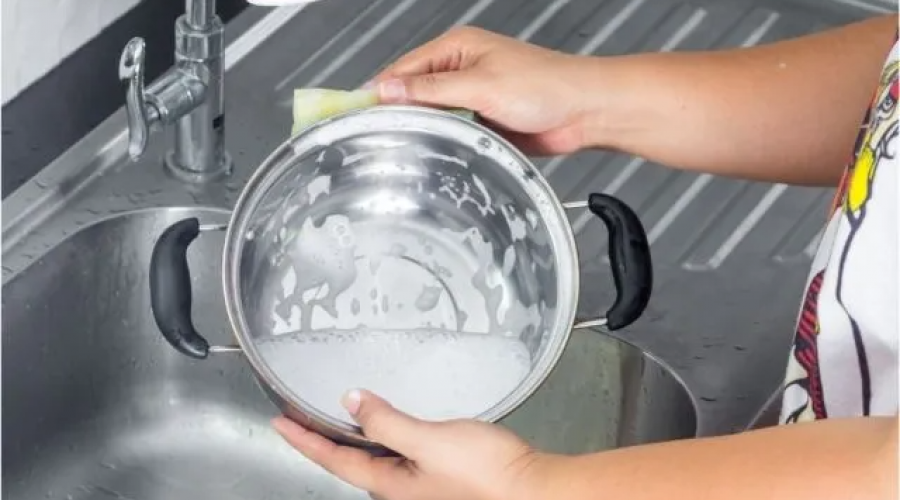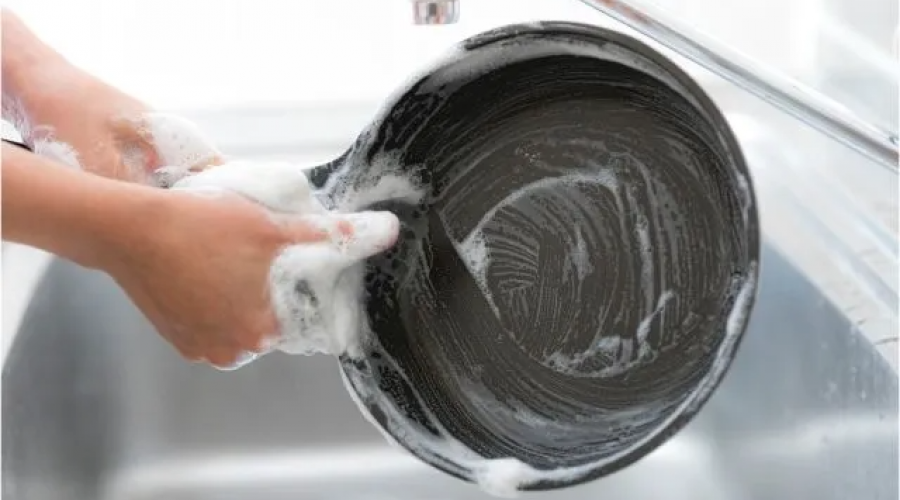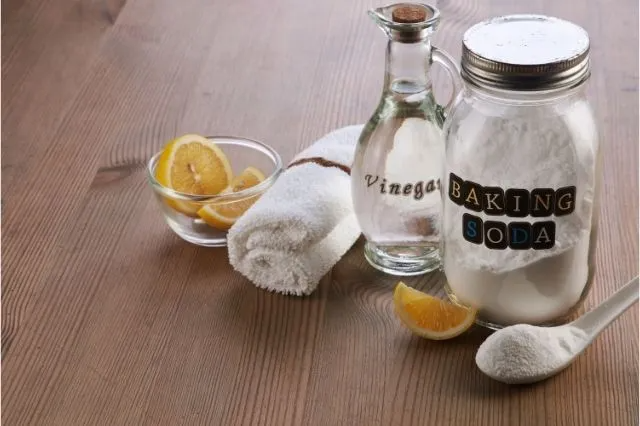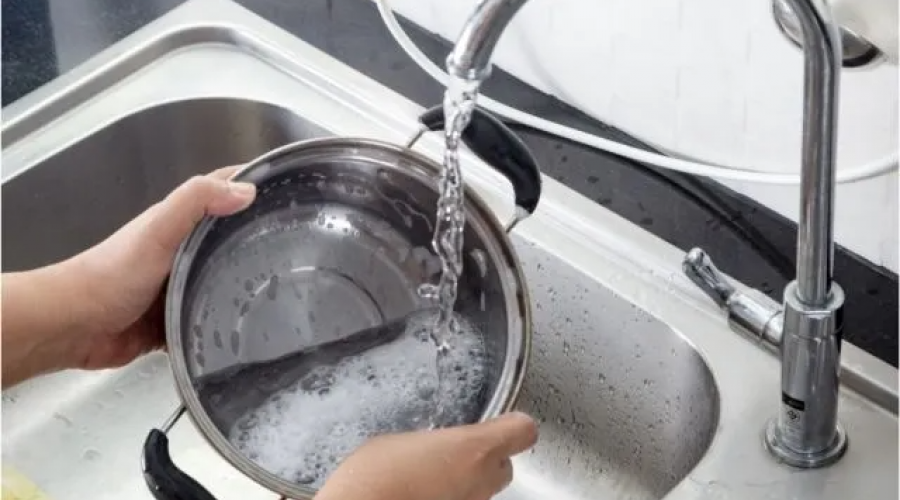Anodized pans are a blessing for those who regularly cook.
These anodized aluminum pans go through a photochemical process of anodizing which helps form a non-stick layer on the surface. This non-stick layer results in easier cooking as the pan can distribute heat evenly.
Hard-anodized pans also help save you time while cooking. While full of great benefits, this type of cookware also requires lots of care.
In order to increase their longevity and make the pans more durable, you should know how to clean hard anodized cookware properly.
If you are worried about taking care of hard-anodized pans, this guide will give you clear instructions on how to clean hard-anodized cookware and take care of it.
Let’s Begin!
Many people prefer hard-anodized pans over others thanks to the numerous benefits they come with.
Compared to stainless steel cookware, hard-anodized cookware is stronger and more durable. The electrochemical process ensures that the cooking surface is durable as well as non-reactive.
Hard anodized pans are covered with a layer of seasoning that is also non-stick by nature. This layer helps prevent any metal from mixing in with the food, making the cookware safe to use.
However, with negligent use, this seasoning can wear off easily. To prevent that, you need to handle your hard-anodized cookware with care and ensure that you clean it gently.
This will not only increase your cookware’s lifespan, but it will make sure that your food is cooked in clean pots and pans.
The following sections will take you through different methods for how to clean hard-anodized cookware. We’ll also answer the most common questions regarding hard-anodized cookware!
How to Take Care of Anodized Pans (Everyday Cleaning)
Hard anodized cookware requires proper care, or else it can become useless over time. To ensure that you take proper care of your cookware, you’ll need to follow these steps:
Cleaning with the Right Cleaner
Cleaners and detergents often contain harsh chemicals that can be damaging to your cookware. Therefore, for hard-anodized aluminum cookware, we recommend you use dishwashing powders that are mild in nature.
This means avoiding any alkaline cleaners. Some light cleaning with warm soapy water should be able to remove the grease or dirt from your cookware, without damaging its surface.

Don’t clean hard-anodized cookware in the dishwasher! This can cause permanent damage to the coating.
Avoid using any kind of household cleaner on the hard-anodized surface. These cleaners usually contain ammonia or bleach which can damage the anodized surface of your cookware.
Cleaning Tools
While it’s important that you scrub the inside of your hard-anodized cookware, you should also ensure that you use a soft-bristled brush. You can also use sponges, dishcloths, or even rags to avoid any damage to the non-stick surface.
Cleaning tools such as steel wool or metal gauze often result in scratches and wear-and-tear to the anodized surface.
Soaking the Cookware Before Cleaning
If you soak your cookware before cleaning, it’ll help make the removal of grease or any food particles much easier.
However, let your cookware cool completely before washing it and use lukewarm water, as soaking hot cookware in cold water can warp your cookware.
Another thing you could do is only put hot cookware in hot water and cold cookware in cold water. This will ensure that the cookware won’t experience thermal shock from the sudden change in temperature.
Method for Cleaning Anodized Aluminum Cookware
To ensure the best care, we recommend that you clean hard-anodized aluminum cookware by hand. To do so, you should use warm water along with mild dish soap.
Using soft-bristled cleaning tools, scrub the surface of your pan until all food particles have been removed.
Once you’re done, rinse the pan until all dish soap has been washed off. After this, dry out your cookware with a soft cloth. Easy as that!

In Case of Difficult Stains
Some food residues can be difficult to remove, no matter how hard you try. In such a case, you should boil a mixture of water and dish soap in your anodized cookware.
Boiling the mixture for about 20-30 minutes will help soften the stains. Once you’re done boiling, you can remove the stain using a soft-bristled scrubber.
Washing Before Use
Before using your hard-anodized cookware in the kitchen, make sure that you’ve washed it properly. This means using warm water and a mild dish cleaner to ensure that there are no leftover food particles on the surface of your cookware. Once you are done washing, dry the pots and pans using a cloth.
Regular cleaning after each use can help avoid any permanent stains while maintaining the quality of your hard-anodized cookware. This will also ensure safe cooking.
Can hard-anodized cookware go in the dishwasher?
It can often be confusing whether hard-anodized cookware is dishwasher friendly or not.
While some companies boast about their cookware being dishwasher-friendly, it is recommended that you hand-wash your anodized cookware anyway.
The reason you should only hand-wash your hard-anodized cookware is because of the non-stick surface. The nonstick nature of the pan requires more care than you might think.
Damaging the pan surface doesn’t only result in the non-stick layer peeling off, but it also reduces the effective functioning of the pan itself.
Dishwashers use hot water and harsh detergents that can be damaging to the pan. Although dishwashers won’t ruin your hard anodized cookware completely, they can negatively affect its performance.
Can You Put Hard-Anodized Cookware in the Oven?
Hard-Anodized pans do not decompose in the oven, as their coating is stable. However, it’s best to check your specific hard-anodized cookware set to be certain.
How to Remove Stains from Hard-Anodized Cookware
There are many different ways to remove stains from your hard-anodized cookware. Let’s take a look at a few of them!
Vinegar
Vinegar is acidic, which can help remove stubborn stains from your anodized cookware. To clean with vinegar, you need to dilute it first:
- Mix a cup of vinegar with 3 cups of water
- Pour the vinegar solution into your hard anodized cookware
- Once your pan has soaked for 15-20 minutes, you will see that the food particles have started dissolving
- You can empty out your cookware and wash it with mild dish soap as you normally would
While washing, make sure that you have gotten rid of all the food and grease particles. After washing and rinsing, you can dry out the cookware with a soft cloth.
Baking Soda
If you can’t stand the smell of vinegar, then you can try out the baking soda method. Baking soda is easily available and it can act as a natural cleaner that’s less abrasive than vinegar.
For cleaning, you’ll need to create a baking soda and water mixture. The consistency of the mixture should be that of a paste so you can coat the pan.
Once you’ve applied the mixture to your hard anodized cookware, you can let it work for about 30-40 minutes. After that, rinse your cookware and dry it with a dishtowel.

Lemon and Salt
If you’re looking for how to clean hard-anodized cookware naturally, you can also use salt and lemon.
The abrasive nature of salt can help clean out stains while lemon’s cleaning abilities can prevent discoloration.
Firstly, you’ll need to mix 1 tablespoon of salt with 1 tablespoon of lemon juice. You can increase the quantity according to your needs, but make sure that the salt to lemon juice ratio remains 1:1.
After you’re done, apply the mixture onto the hard anodized cookware surface and let it rest for 30 minutes. Then gently remove the mixture and rinse out your cookware.
You’ll not only get rid of the stains through this method but can also restore the color of your cookware. This technique can especially be useful if you’ve burnt your hard anodized cookware.
How To Restore Hard-Anodized Cookware Interior
It’s not fun having to replace your hard-anodized cookware frequently, which is why you should know how to restore it.
If your non-stick surface starts coming off, you’ll notice that your food will start sticking to the surface. This will also result in the chemicals mixing into the food you’re cooking. To prevent this, you can add a protective coating to your cookware.
Most pans come with their own instructions, which you can easily follow to ensure that the seasoning on the surface remains intact.
How to Clean Blackened Aluminum Pots
Burnt residues or stains can stick to the surface of your hard-anodized aluminum cookware after cooking. To get rid of this burnt surface, you should soak your cookware in warm water mixed with dish soap.
If the stains are hard to remove, you can boil dish soap water in the cookware. The heat will help soften the burnt surface for easy removal. After 30 minutes, you can rinse out the cookware with water and dry it.
For any burnt parts on the exterior of your anodized cookware, you can use baking soda or a lemon mixture to clean it more effectively. After letting the mixture sit for 30 minutes, you can rinse and scrub the cookware with a sponge or a soft-bristled cleaning tool.
This will ensure that any burnt parts on the exterior are removed and your cookware looks as good as new!

Best Ways to Clean Hard-Anodized Pans
You may have thought that taking care of hard-anodized cookware can be tricky. Well, hopefully, this article has debunked that myth and shown you how to clean hard-anodized cookware.
Since hard-anodized cookware requires some special care, it’s essential that you know how to take care of it. Try out which cleaning method is the most effective and see if it suits you.
Once you do that, you’ll realize it’s quite easy to take care of your hard-anodized pots and pans while protecting their durability and lifespan. With clean hard-anodized cookware, you’ll also be able to cook food in a safe manner.
MORE ABOUT HARD ANODIZED COOKWARE: Best Hard Anodized Cookware Set – Buyer’s Guide